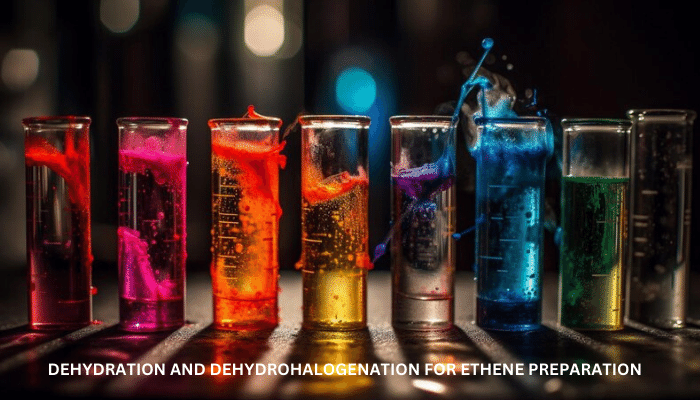
Learning Outcomes:
i. Define dehydration and dehydrohalogenation reactions and their significance in organic synthesis.
ii. Comprehend the mechanisms of dehydration and dehydrohalogenation reactions using ethanol and alkyl halides as examples.
iii. Recognize the factors affecting the regioselectivity of dehydration reactions, including the stability of alkenes formed.
iv. Apply the concepts of dehydration and dehydrohalogenation to prepare ethene from various starting materials.
v. Appreciate the importance of these reactions in industrial production and laboratory synthesis of ethene.
Introduction
Ethene, commonly known as ethylene, is a versatile and widely used alkene with numerous applications in the chemical industry. In this lesson, we delve into the preparation of ethene through two key synthetic routes: dehydration of alcohols and dehydrohalogenation of alkyl halides.
i. Dehydration of Alcohols: Eliminating Water to Form Ethene
Dehydration of alcohols, also known as elimination reactions, involves the removal of a water molecule from an alcohol to produce an alkene. The general reaction is as follows:
Alcohol → Alkene + Water
The reaction is typically catalyzed by an acidic substance, such as sulfuric acid or phosphoric acid, which provides protons to facilitate the elimination of water.
ii. Mechanism of Dehydration:
Protonation: The proton from the acid attaches to the oxygen atom of the alcohol, forming a protonated alcohol intermediate.
Formation of Carbocation: The protonated alcohol loses a water molecule, generating a carbocation intermediate.
Hydride Shift: A hydride ion (H-) shifts from an adjacent carbon atom to the carbocation, forming an alkene and regenerating the acid catalyst.
iii. Regioselectivity in Dehydration Reactions:
The regioselectivity of dehydration reactions is influenced by the stability of the alkenes produced. More stable alkenes are formed preferentially. For instance, dehydration of 2-propanol favors the formation of 2-propene (propylene) over 1-propene due to the stability of the tertiary carbocation intermediate.
iv. Dehydrohalogenation of Alkyl Halides: Removing HX to Form Ethene
Dehydrohalogenation of alkyl halides, another elimination reaction, involves the removal of a hydrogen halide (HX) from an alkyl halide to produce an alkene. The general reaction is as follows:
Alkyl Halide → Alkene + Hydrogen Halide
The reaction is typically catalyzed by a strong base, such as sodium hydroxide or potassium hydroxide, which provides hydroxide ions to facilitate the elimination of HX.
v. Mechanism of Dehydrohalogenation:
Formation of Alkoxide: The hydroxide ion attacks the alkyl halide, forming an alkoxide intermediate.
Elimination of HX: The alkoxide ion loses a proton and the halide ion, generating an alkene and regenerating the base catalyst.
vi. Regioselectivity in Dehydrohalogenation Reactions:
Similarly to dehydration reactions, the regioselectivity of dehydrohalogenation reactions is governed by the stability of the alkenes formed. More substituted alkenes are favored due to the stability of the carbocation intermediates. For instance, dehydrohalogenation of 2-bromopropane favors the formation of 2-propene over 1-propene.
vii. Applications of Dehydration and Dehydrohalogenation Reactions
These reactions play crucial roles in the industrial production and laboratory synthesis of ethene:
Industrial Production: Ethene is primarily produced through the steam cracking of naphtha, a petroleum fraction. This process involves dehydration and dehydrohalogenation reactions.
Laboratory Synthesis: In the laboratory, ethene can be prepared from alcohols or alkyl halides using dehydration and dehydrohalogenation reactions. These reactions provide a convenient method for small-scale ethene synthesis.
Dehydration and dehydrohalogenation reactions are versatile tools for the synthesis of ethene, a cornerstone of the chemical industry. Understanding the mechanisms, regioselectivity factors, and applications of these reactions is essential for organic synthesis and industrial processes.